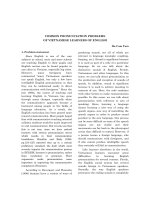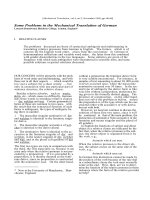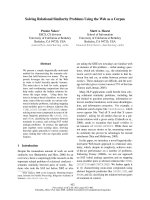Drilling problems 2
Bạn đang xem bản rút gọn của tài liệu. Xem và tải ngay bản đầy đủ của tài liệu tại đây (2.09 MB, 44 trang )
TẬP ĐOÀN DẦU KHÍ VIỆT NAM
TRƯỜNG ĐẠI HỌC DẦU KHÍ VIỆT NAM
Drilling Problems
Seminar on April
Pipe Sticking
Pipe Failure
Lost Circulation
Borehole
Instability
Hole Deviation
Mud
Contamination
Formation
Damage
Abnormal High
Pressure
Equipment &
Personnel…
Outline
Problems
• Pipe Sticking
• Pipe Failure
• Borehole Instability
• Lost Circulation
• Hole Deviation
• Formation Damage
• Mud Contamination
• Equipment & Personnel Related
• Abnormal High Pressure
Pipe Sticking
Pipe Failure
Lost Circulation
Borehole
Instability
Hole Deviation
Mud
Contamination
Formation
Damage
Abnormal High
Pressure
Equipment &
Personnel…
Pipe Sticking
• Definition: pipe is called stuck if it can not be freed or pulled out
of the hole with out damaging and exceeding the rig’s maximum
allowable hook load.(is the situation when drilling string become stuck due to either mechenical problems or differential-pressure pipe sticking)
• Classification: There
are two types of pipe
sticking
• Differential-pressure
pipe sticking
• Mechanical pipe
sticking
Pipe Sticking
Pipe Failure
Lost Circulation
Borehole
Instability
Hole Deviation
Mud
Contamination
Formation
Damage
Abnormal High
Pressure
Equipment &
Personnel…
Differential Pipe Sticking
• Differential pipe sticking:
occurs when a portion of
drillstring become
embedded in a mud-cake
• Causes:
• The mud pressure, Pm, which
acts on outside wall of the
pipe, is greater than the
formation-fluid pressure, Pff,
Pipe Sticking
Pipe Failure
Lost Circulation
Borehole
Instability
Hole Deviation
Mud
Contamination
Formation
Damage
Abnormal High
Pressure
Equipment &
Personnel…
Differential Pipe Sticking
• Causes
• Long or oversized drill collar strings
• Deviated hole
• Poor mud quality
• Interruption of pipe movement,
circulation
Pipe Sticking
Pipe Failure
Lost Circulation
Borehole
Instability
Hole Deviation
Mud
Contamination
Formation
Damage
Abnormal High
Pressure
Equipment &
Personnel…
Differential Pipe Sticking
• Solution
• Precaution
• Maintain the lowest continuous fluid loss
• Maintain the lowest level of drilled solids in the mud system or remove all
drilled solid
• Use the lowest differecial pressure with allowance of swab and surge
pressures during tripping operation
• Select a mud system will yield a smooth mudcake ( low coefficient of
friction)
• Maintain drillstring rotation at all time if possible
• If sticking does occur
• The driller first tries to free pipe by jarring with a jar in drillstring
• Freeing stuck pipe include mud-hydrostatic-pressure reduction in annulus,
oil spotting around the stuck and washing over stuckpipe
Pipe Sticking
Pipe Failure
Lost Circulation
Borehole
Instability
Hole Deviation
Mud
Contamination
Formation
Damage
Abnormal High
Pressure
Equipment &
Personnel…
Machanical Pipe Sticking
• Machanical pipe sticking: caused by inadequate re-
moval of drilled-cuttings from the annulus, borehole
instabilities such as hole caving, sloughing or collapse,
plastic shale or salt sections creeping, key seating.
• Drilled-cuttings
• Borehole instabilities
• Keyseat
• Causes:
Pipe Sticking
Pipe Failure
Lost Circulation
Borehole
Instability
Hole Deviation
Mud
Contamination
Formation
Damage
Abnormal High
Pressure
Equipment &
Personnel…
Mechanical Pipe Sticking
Drilled cuttings
Pipe Sticking
Pipe Failure
Lost Circulation
Borehole
Instability
Hole Deviation
Mud
Contamination
Formation
Damage
Abnormal High
Pressure
Equipment &
Personnel…
Mechanical Pipe Sticking
Pipe Sticking
Pipe Failure
Lost Circulation
Borehole
Instability
Hole Deviation
Mud
Contamination
Formation
Damage
Abnormal High
Pressure
Equipment &
Personnel…
Mechanical Pipe Sticking
Borehole Instability
Pipe Sticking
Pipe Failure
Lost Circulation
Borehole
Instability
Hole Deviation
Mud
Contamination
Formation
Damage
Abnormal High
Pressure
Equipment &
Personnel…
Mechanical Pipe Sticking
Key seat
Pipe Sticking
Pipe Failure
Lost Circulation
Borehole
Instability
Hole Deviation
Mud
Contamination
Formation
Damage
Abnormal High
Pressure
Equipment &
Personnel…
Machanical Pipe Sticking
• Solution: depending on what caused pipe sticking
• If cutting accumulation or hole sloughing is the cause, then
rotating and reciprocating the drillstring and increasing the
flow rate
• If hole narrowing as a result of salt is the cause, then
circulating fresh water can free the pipe
• If the pipe is stuck in a key-seat area, the most likely
successful solution is backing off below the key seat and
going back into the hole with an opener to drill out the key
section. This will lead to a FISHING operation to retrieve the
fish.
Pipe Sticking
Pipe Failure
Lost Circulation
Borehole
Instability
Hole Deviation
Mud
Contamination
Formation
Damage
Abnormal High
Pressure
Equipment &
Personnel…
Drillpipe Failures
• Drillpipe failures: contain the following categories: twist-
off, parting, burst or collapse, fatigue
• Twist-off caused by excessive torque
• Parting caused by excessive tensile
• Burst or collapse due to excessive internal or external
pressure, respectively
• Fatigue as a result of mechanical cyclic loads with or without
corrosion
Pipe Sticking
Pipe Failure
Lost Circulation
Borehole
Instability
Hole Deviation
Mud
Contamination
Formation
Damage
Abnormal High
Pressure
Equipment &
Personnel…
Fishing
• Fishing tools use to retrieve fishes or junks which
break off and fall down the well during drilling
Pipe Sticking
Pipe Failure
Lost Circulation
Borehole
Instability
Hole Deviation
Mud
Contamination
Formation
Damage
Abnormal High
Pressure
Equipment &
Personnel…
Bore Hole Instability
• Definition: borehole
instability is a condition of
an open hole interval that
does not maintain gauge
size and shape and/or it’s
integrity.
Pipe Sticking
Pipe Failure
Lost Circulation
Borehole
Instability
Hole Deviation
Mud
Contamination
Formation
Damage
Abnormal High
Pressure
Equipment &
Personnel…
Borehole Instability
• Causes: mechanical failure caused by in-situ stresses,
erosion caused by fluid circulation, chemical caused by
interaction of borehole fluid with formation
• Types and associated problems: There are 4 types of
bore hole instability: hole closure, hole enlargement,
fracturing, collapse.
• Hole closure or narrowing: occurs in shale or salt section.
Associated problems are an increase in torque and drag,
potential pipe sticking, difficulty of casing landing.
Pipe Sticking
Pipe Failure
Lost Circulation
Borehole
Instability
Hole Deviation
Mud
Contamination
Formation
Damage
Abnormal High
Pressure
Equipment &
Personnel…
Borehole Instability
• Hole enlargement or washouts: are generally caused by
hydraulic erosion, mechanical abrasion by drillstring, and
inherently sloughing shale. Problems associated with hole
enlargement are an increase in cementing difficulty,
potential hole deviation, hydraulic equipment for effective
hole cleaning and potential problem during logging
operations
• Fracturing: occurs when the wellbore drilling-fluid pressure
exceeds the formation fracture pressure. The associated
problems are lost circulation and possible kick occurrence
• Collapse. Borehole collapse occurs when the drilling-fluid
pressure is too low to maintain the structural integrity of the
drilled hole. The associated problems are pipe sticking and
possible loss of well.
Pipe Sticking
Pipe Failure
Lost Circulation
Borehole
Instability
Hole Deviation
Mud
Contamination
Formation
Damage
Abnormal High
Pressure
Equipment &
Personnel…
Borehole Instability
• Solution:
These practices include proper mud-weight selection
and maintenance, the use of proper hydraulics to
control the ECD, proper hole-trajectory selection, and
the use of borehole fluid compatible with the formation
being drilled. Additional field practices that should be
followed are minimizing time spent in open hole; using
offset-well data (use of the learning curve); monitoring
trend changes (torque, circulating pressure, drag, fill-in
during tripping); and collaborating and sharing
information.
Pipe Sticking
Pipe Failure
Lost Circulation
Borehole
Instability
Hole Deviation
Mud
Contamination
Formation
Damage
Abnormal High
Pressure
Equipment &
Personnel…
Lost Circulation
• Definition: Lost circulation is the reduced or total
absence of fluid flow up the formation-casing or
casing-tubing annulus when the fluid is pumped down
drillpipe or casing
Pipe Sticking
Pipe Failure
Lost Circulation
Borehole
Instability
Hole Deviation
Mud
Contamination
Formation
Damage
Abnormal High
Pressure
Equipment &
Personnel…
Lost Circulation
• Classification
• Less than 10bbl/hr
Seepage
• Greater thanh 10bbl/hr,
but some fluit returns
Partial lost
returns
• No fluit comes out from
the anulus
Total lost
circulation
Pipe Sticking
Pipe Failure
Lost Circulation
Borehole
Instability
Hole Deviation
Mud
Contamination
Formation
Damage
Abnormal High
Pressure
Equipment &
Personnel…
Lost Circulation
Cause:
Pipe Sticking
Pipe Failure
Lost Circulation
Borehole
Instability
Hole Deviation
Mud
Contamination
Formation
Damage
Abnormal High
Pressure
Equipment &
Personnel…
Lost Circulation
• Prevention of lost circulation
• Maintain proper mud weight
• Minimize annular-friction
pressure losses
• Control drill to ensure
goodhole cleaning
• Set casing to protect
weak formations
• Update information pore
pressure and fracture gradients
Pipe Sticking
Pipe Failure
Lost Circulation
Borehole
Instability
Hole Deviation
Mud
Contamination
Formation
Damage
Abnormal High
Pressure
Equipment &
Personnel…
Lost Circulation
• Solution
• Keep drilling if the geological condition allow
• In the case of severe lost circulations, use lost-
circulation materials (LCMs) (video)
Pipe Sticking
Pipe Failure
Lost Circulation
Borehole
Instability
Hole Deviation
Mud
Contamination
Formation
Damage
Abnormal High
Pressure
Equipment &
Personnel…
Hole Deviation
• Definition:
Hole deviation is the unintentional departure of the drill bit
from a preselected borehole trajectory
Pipe Sticking
Pipe Failure
Lost Circulation
Borehole
Instability
Hole Deviation
Mud
Contamination
Formation
Damage
Abnormal High
Pressure
Equipment &
Personnel…
Hole Deviation
• Causes:
• Heterogeneous nature of formation and dip angle.
• Drillstring characteristics, specifically the BHA makeup.
• Stabilizers (location, number, and clearances)
• Applied weight on bit (WOB).
• Hole-inclination angle from vertical.
• Drill-bit type and its basic mechanical design.
• Hydraulics at the bit.
• Improper hole cleaning.









